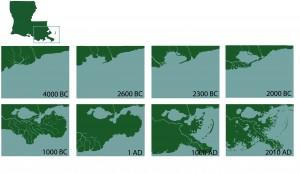Coastal infrastructureSoutheastern Louisiana has a problem: "The sea is rising and the land is sinking"
Southeastern Louisiana is drowning at the rate of one football field per hour, totaling up to sixteen square miles annually. In just eighty years, sea level rise, fossil fuel extraction, and having too few wetlands separating the Gulf from the flood protection levee systems have caused some 2,000 square miles of Louisiana’s coastal landscape to sink into the Gulf of Mexico. The issues facing Louisiana’s southeastern coast pose a threat to American energy and economic stability. A $50 billion, 50-year coastal restoration plan, formulated in 2007, is yet to be accepted and funded, but experts note that if sea-level rise is as bad as the worst case scenario, several projects at the heart of the restoration plan would become infective.

Map illustrating the sinking of part of Lousiana // Source: commons.wikimedia.org
In just eighty years, sea level rise, fossil fuel extraction, and having too few wetlands separating the Gulf from the flood protection levee systems have caused some 2,000 square miles of Louisiana’s coastal landscape to sink into the Gulf of Mexico, according to the report, Losing Ground, a journalism collaboration between ProPublica and The Lens. “The sea is rising and the land is sinking,” says Louisiana state climatologist Barry Keim. “The two together mean that wetlands are disappearing here at unprecedented rates worldwide.” With more powerful hurricanes spurred by climate change expected in the coming years, “you have to worry about the past repeating itself here,” Keim says.
Southeastern Louisiana is drowning at the rate of one football field per hour, totaling up to sixteen square miles annually. The National Oceanic and Atmospheric Administration (NOAA) predicts that by 2100, southeastern Louisiana could be under at least 4.3 feet of water coming from the Gulf of Mexico. The issues facing Louisiana’s southeastern coast, where the majority of U.S. domestic wild seafood is caught, and home to “half of the country’s oil refineries, a matrix of pipelines that serve 90 percent of the nation’s offshore energy production and 30 percent of its total oil and gas supply, a port vital to 31 states, and 2 million people who would need to find other places to live,” pose a threat to American energy and economic stability.
For this reason, and the public shock that followed Hurricane Katrina, the state legislature and the Louisiana Coastal Protection and Restoration Authority (CPRA) in 2007 proposed a $50 billion, 50-year coastal restoration plan which includes at least thirty-nine projects to restore marshes, build levees, pump sediment into sinking areas, rebuild barrier islands, and “build massive diversions on the river to reconnect it with the dying delta.” If completed by 2060, the plan could lead to more land built annually than is lost to the Gulf.
The plan, however, is underfunded and CPRA has so far been unsuccessful in getting Congress to contribute money. Efforts to get the oil and gas industry to contribute a larger share of funds to coastal restoration plans have been unsuccessful, and current funding sources will only keep the plan on schedule through 2019. Furthermore, if sea-level rise is as bad as the worst case scenario, several projects may become infective, and building sediment diversions on the river, a key part of the project’s land-building strategy, has never been done before — architectural predictions are largely hypothetical.
Tim Osborn, the Navigation Manager - Central Gulf Region, of the NOAA’s Office of Coast Survey, has criticized Louisiana’s $50 billion plan, saying that while “valuable and thoughtful,” it has a major flaw. “The problem is it’s a master plan for the restoration and conservation of a landscape that is moving downward at a faster rate than we realized when the plan was constructed — a rate faster than any place else we are seeing in the world for such a large land area,” said Osborn. “With all due respect,” he said, “they have projects designed to last 50 years at one level of relative sea-level rise, when they should be building projects that can function for several generations as sea level rises twice as high, if not higher.”
Garret Graves, former head of CPRA, in 2013 said the restoration plan is structured to adapt to changing circumstances, and the CPRA must submit an updated plan to the state legislature for approval every five years.
